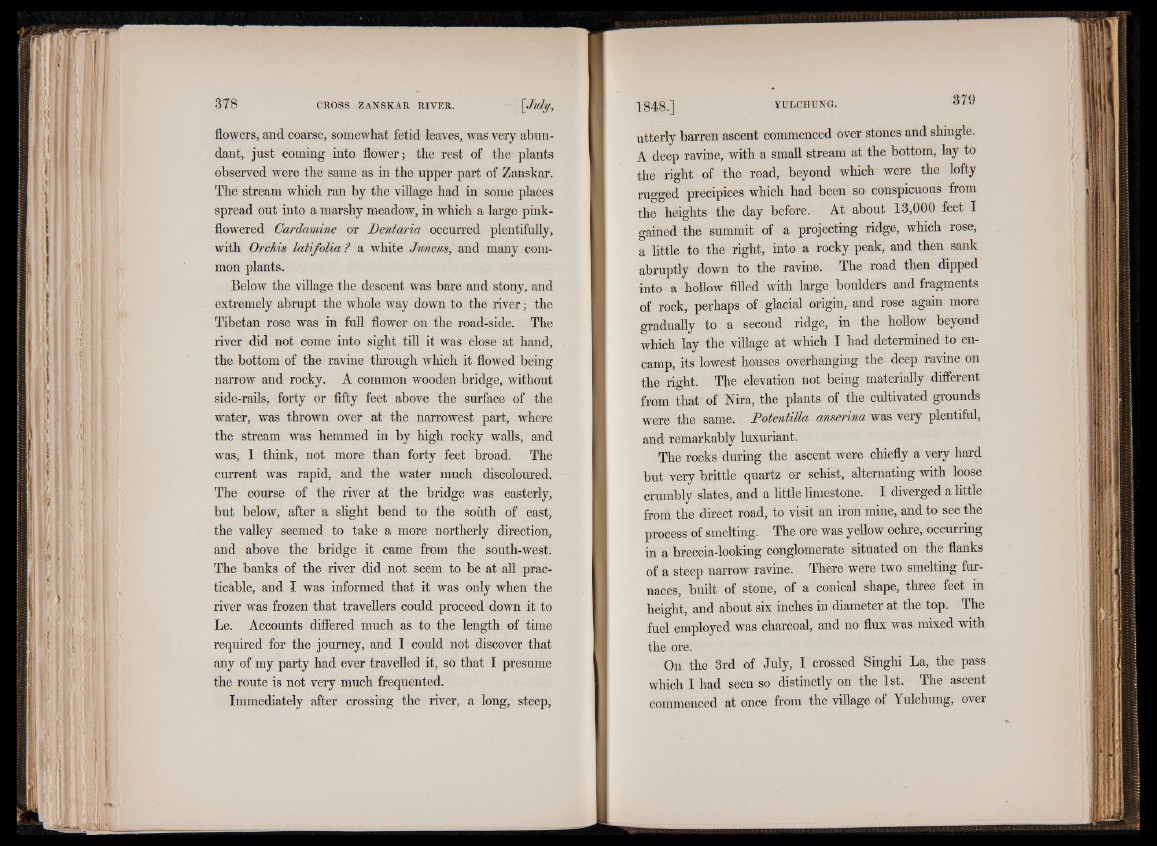
flowers, and coarse, somewhat fetid leaves, was very abundant,
just coming into flower; the rest of the plants
observed were the same as in the upper part of Zanskar.
The stream which ran by the village had in some places
spread out into a marshy meadow, in which a large pink-
flowered Cardamine or Dentaria occurred plentifully,
with Orchis latifcilia ? a white Juncus, and many common
plants.
Below the village the descent was bare and stony, and
extremely abrupt the whole way down to the river; the
Tibetan rose was in full flower on the road-side. The
river did not come into sight till it was close at hand,
the bottom of the ravine through which it flowed being
narrow and rocky. A common wooden bridge, without
side-rails, forty or fifty feet above the surface of the
water, was thrown over at the narrowest part, where
the stream was hemmed in by high rocky walls, and
was, I think, not more than forty feet broad. The
current was rapid, and the water much discoloured.
The course of the river at the bridge was easterly,
but below, after a slight bend to the south of east,
the valley seemed to take a more northerly direction,
and above the bridge it came from the south-west.
The banks of the river did not seem to be at all practicable,
and I was informed that it was only when the
river was frozen that travellers could proceed down it to
Le. Accounts differed much as to the length of time
required for the journey, and I could not discover that
any of my party had ever travelled it, so that I presume
the route is not very much frequented.
Immediately after crossing the river, a long, steep,
utterly barren ascent commenced over stones and shingle.
A deep ravine, with a small stream at the bottom, lay to
the right of the road, beyond which were the lofty
rugged precipices which had been so conspicuous from
the heights the day before. At about 13,000 feet I
gained the summit of a projecting ridge, which rose,
a little to the right, into a rocky peak, and then sank
abruptly down to the ravine. The road then dipped
into a hollow filled with large boulders and fragments
of rock, perhaps of glacial origin, and rose again more
gradually to a second ridge, in the hollow beyond
which lay the village at which I had determined to encamp,
its lowest houses overhanging the deep ravine on
the right. The elevation not being materially different
from that of Nira, the plants of the cultivated grounds
were the same. Potentilla anserina was very plentiful,
and remarkably luxuriant.
The rocks during the ascent were chiefly a very hard
but very brittle quartz or schist, alternating with loose
crumbly slates, and a little limestone. I diverged a little
front the direct road, to visit an iron mine, and to see the
process of smelting. The ore was yellow ochre, occurring
in a breccia-looking conglomerate situated on the flanks
of a steep narrow ravine. There were two smelting furnaces,
built of stone, of a conical shape, three feet in
height, and about six inches in diameter at the top. The
fuel employed was charcoal, and no flux was mixed with
the ore.
On the 3rd of July, I crossed Singhi La, the pass
which I had seen so distinctly on the 1st. The ascent
commenced at once from the village of Yulchung, over